15种固定句式翻译练习答案
- 格式:doc
- 大小:18.00 KB
- 文档页数:2
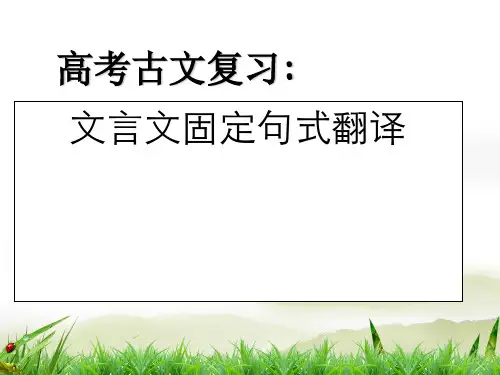
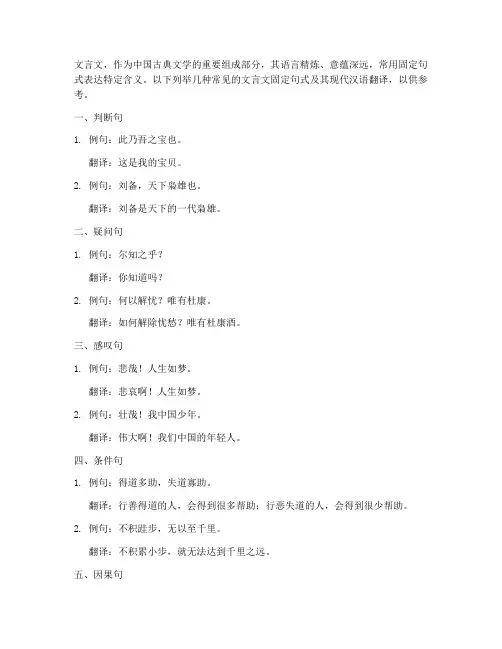
文言文,作为中国古典文学的重要组成部分,其语言精炼、意蕴深远,常用固定句式表达特定含义。
以下列举几种常见的文言文固定句式及其现代汉语翻译,以供参考。
一、判断句1. 例句:此乃吾之宝也。
翻译:这是我的宝贝。
2. 例句:刘备,天下枭雄也。
翻译:刘备是天下的一代枭雄。
二、疑问句1. 例句:尔知之乎?翻译:你知道吗?2. 例句:何以解忧?唯有杜康。
翻译:如何解除忧愁?唯有杜康酒。
三、感叹句1. 例句:悲哉!人生如梦。
翻译:悲哀啊!人生如梦。
2. 例句:壮哉!我中国少年。
翻译:伟大啊!我们中国的年轻人。
四、条件句1. 例句:得道多助,失道寡助。
翻译:行善得道的人,会得到很多帮助;行恶失道的人,会得到很少帮助。
2. 例句:不积跬步,无以至千里。
翻译:不积累小步,就无法达到千里之远。
五、因果句1. 例句:天行健,君子以自强不息。
翻译:天地运行不息,君子应自强不息。
2. 例句:天下兴亡,匹夫有责。
翻译:国家的兴衰,每个普通人都负有责任。
六、并列句1. 例句:仁者见之而思,智者见之而行。
翻译:有仁德的人见到它就会思考,有智慧的人见到它就会行动。
2. 例句:穷则独善其身,达则兼善天下。
翻译:不得志时就修养自己的品德,得志时就使天下人都得到好处。
七、省略句1. 例句:吾欲与汝同往。
翻译:我想和你一起去。
2. 例句:君不见黄河之水天上来,奔流到海不复回。
翻译:你难道没看见黄河之水从天上流下来,奔流到海就再也回不去了吗?以上仅为文言文中常见的一些固定句式及翻译,希望能对大家学习文言文有所帮助。
在学习过程中,要多加练习,逐渐掌握这些固定句式,提高文言文阅读和翻译能力。
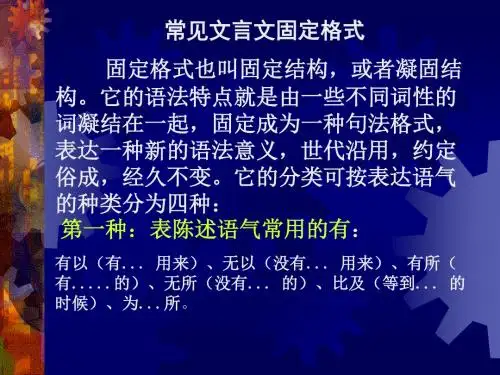
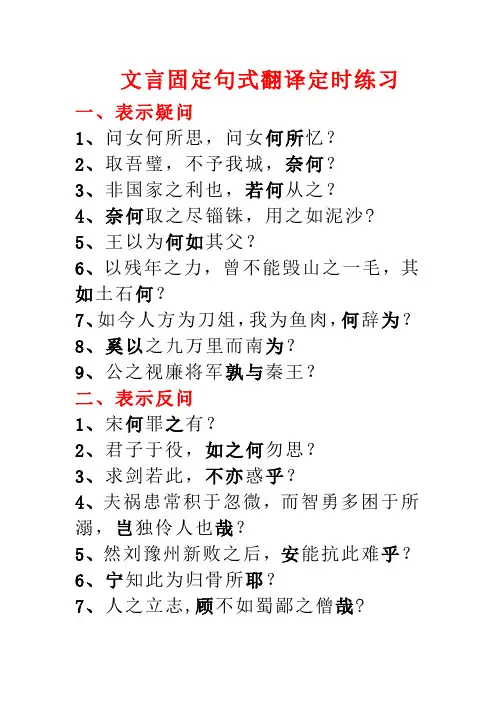
文言固定句式翻译定时练习一、表示疑问1、问女何所思,问女何所忆?2、取吾璧,不予我城,奈何?3、非国家之利也,若何从之?4、奈何取之尽锱铢,用之如泥沙?5、王以为何如其父?6、以残年之力,曾不能毁山之一毛,其如土石何?7、如今人方为刀俎,我为鱼肉,何辞为?8、奚以之九万里而南为?9、公之视廉将军孰与秦王?二、表示反问1、宋何罪之有?2、君子于役,如之何勿思?3、求剑若此,不亦惑乎?4、夫祸患常积于忽微,而智勇多困于所溺,岂独伶人也哉?5、然刘豫州新败之后,安能抗此难乎?6、宁知此为归骨所耶?7、人之立志,顾不如蜀鄙之僧哉?8、相如虽驽,独畏廉将军哉?9、圣人之所以为圣,愚人之所以为愚,其皆出于此乎?10、吾师道也,夫庸之其年之先后生于吾乎?三、表示感叹1、止增笑耳。
嗟夫,孟尝君特鸡鸣狗盗之雄耳。
直不百步耳,是亦走也。
2、吏呼一何怒,妇啼一何苦四、表揣度1、无乃与仆私心刺谬乎?2、成反复自念,得无教我猎虫耶?3、庶几可告慰先生也。
五、表示选择1、与其坐而待亡,孰若起而拯之。
2、抑本其成败之迹,而皆自于人欤?3、呜呼!其(难道)信然邪?其梦邪?其传之非真邪?六、表示其他1、死亦我所恶,所恶有甚于死者,故患有所不避也。
2、今入关,财物无所取,妇女无所幸,此其志不在小。
3、谚所谓“唇亡齿寒”者,其虞虢之谓也。
此之谓失其本心。
4、吾终当有以活汝。
5、军中无以为乐。
6、非惟天时,抑亦人谋也。
7、今以钟磬置水中,虽大风浪不能鸣也,而况石乎?。
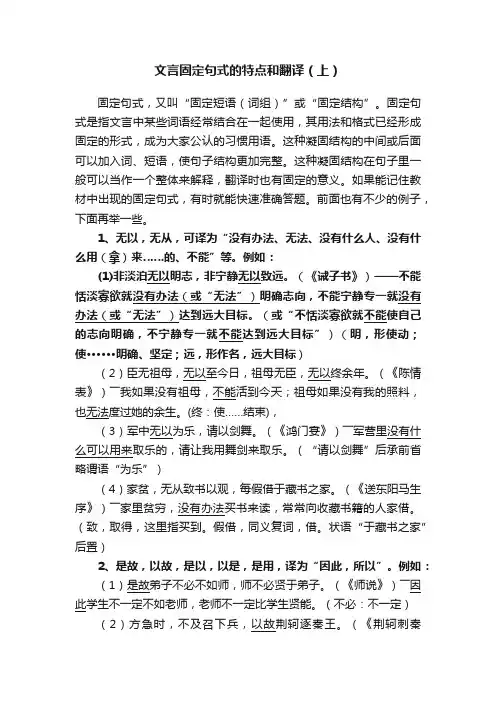
文言固定句式的特点和翻译(上)固定句式,又叫“固定短语(词组)”或“固定结构”。
固定句式是指文言中某些词语经常结合在一起使用,其用法和格式已经形成固定的形式,成为大家公认的习惯用语。
这种凝固结构的中间或后面可以加入词、短语,使句子结构更加完整。
这种凝固结构在句子里一般可以当作一个整体来解释,翻译时也有固定的意义。
如果能记住教材中出现的固定句式,有时就能快速准确答题。
前面也有不少的例子,下面再举一些。
1、无以,无从,可译为“没有办法、无法、没有什么人、没有什么用(拿)来……的、不能”等。
例如:(1)非淡泊无以明志,非宁静无以致远。
(《诫子书》)——不能恬淡寡欲就没有办法(或“无法”)明确志向,不能宁静专一就没有办法(或“无法”)达到远大目标。
(或“不恬淡寡欲就不能使自己的志向明确,不宁静专一就不能达到远大目标”)(明,形使动;使······明确、坚定;远,形作名,远大目标)(2)臣无祖母,无以至今日,祖母无臣,无以终余年。
(《陈情表》)――我如果没有祖母,不能活到今天;祖母如果没有我的照料,也无法度过她的余生。
(终:使……结束),(3)军中无以为乐,请以剑舞。
(《鸿门宴》)――军营里没有什么可以用来取乐的,请让我用舞剑来取乐。
(“请以剑舞”后承前省略谓语“为乐”)(4)家贫,无从致书以观,每假借于藏书之家。
(《送东阳马生序》)――家里贫穷,没有办法买书来读,常常向收藏书籍的人家借。
(致,取得,这里指买到。
假借,同义复词,借。
状语“于藏书之家”后置)2、是故,以故,是以,以是,是用,译为“因此,所以”。
例如:(1)是故弟子不必不如师,师不必贤于弟子。
(《师说》)――因此学生不一定不如老师,老师不一定比学生贤能。
(不必:不一定)(2)方急时,不及召下兵,以故荆轲逐秦王。
(《荆轲刺秦王》)――(秦王)正处在危急时刻,来不及召唤台阶下的侍卫,所以荆轲能追赶秦王。
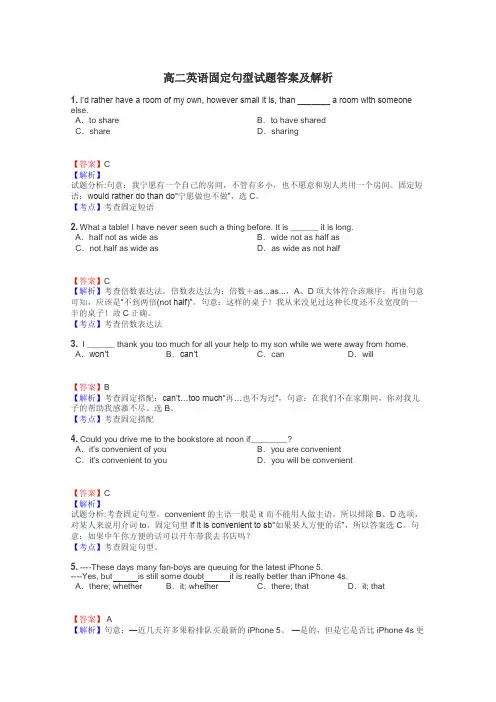
高二英语固定句型试题答案及解析1.I’d rather have a room of my own, however small it is, than _______ a room with someone else.A.to share B.to have sharedC.share D.sharing【答案】C【解析】试题分析:句意:我宁愿有一个自己的房间,不管有多小,也不愿意和别人共用一个房间。
固定短语:would rather do than do“宁愿做也不做”,选C。
【考点】考查固定短语2. What a table! I have never seen such a thing before. It is ______ it is long.A.half not as wide as B.wide not as half asC.not half as wide as D.as wide as not half【答案】C【解析】考查倍数表达法。
倍数表达法为:倍数+as...as...,A、D项大体符合该顺序;再由句意可知,应该是“不到两倍(not half)”。
句意:这样的桌子!我从来没见过这种长度还不及宽度的一半的桌子!故C正确。
【考点】考查倍数表达法3. I ______ thank you too much for all your help to my son while we were away from home. A.won’t B.can’t C.can D.will【答案】B【解析】考查固定搭配:can’t…too much“再…也不为过”,句意:在我们不在家期间,你对我儿子的帮助我感激不尽。
选B。
【考点】考查固定搭配4. Could you drive me to the bookstore at noon if________?A.it's convenient of you B.you are convenientC.it's convenient to you D.you will be convenient【答案】C【解析】试题分析:考查固定句型。

常见固定句式及其翻译固定句式也叫固定结构,它的语法特点就是由一些不同词性的词凝结在一起,固定成为一种句法格式,表达一种新的语法意义,世代沿袭,约定俗称,经久不变。
这些固定结构可以分为以下几种类型:一、表示某种语气的固定结构1.表判断语气。
(1)常见的有“无以”“所以”或“者…也”等。
①故不积跬步,无以至千里;不积小流,无以成江海。
——《荀子·劝学》②臣无祖母,无以至今日;祖母无臣,无以终余年。
——李密《陈情表》“无以”相当于“没有用来…的办法”。
③师者,所以传道受业解惑也。
——韩愈《师说》“所以”相当于“是用来…的”。
④亚父者,范增也。
——司马迁《鸿门宴》⑤非我所谓传其道解其惑者也。
——韩愈《师说》“者…也”表判断是常见的,还有“者也”连用等,例句很多,不再赘述。
(2)“……之谓也”(用在句末,表示总结性判断的固定结构,又是宾语前置的结构。
)—般译为:“说的就是……”或“大概说的就是……吧”。
“……之谓……”(用在句中,宾语在“谓”的后边,这里的“之”是助词,用在主谓之间,取消句子的独立性)——“……叫作……”、“……称作……”、“……认为……”、“……说……”。
①“诗云:‘他人有心,子忖度之。
’——夫子之谓也。
”——译文:“《诗》里面讲过:‘别人有想法,我能猜中它。
’——(这话)说的就是夫子您这样的人。
②“野有之曰:‘闻道百,以为莫己若’者,我之谓也。
”——译文:"俗语说:'知道了很多道理,自以为没人能赶上自已了。
'这说的就是我呀。
”③宜乎,百姓之谓我爱也。
——译文:百姓认为我吝啬,看来是理所当然的了。
④此之谓失其本心。
(孟子《鱼我所欲也》)译文:这叫作失去了他的羞耻之心。
2. 表疑问语气。
表疑问语气的固定句式比较多,常见的有:(1)如……何、若……何、奈……何;中间可插入名词代词和短语,可译为“把……怎么样”“对……怎么办”“怎样对付(处置、安顿)。
例句:以君之力,曾不能损魁父之丘,如太行、王屋何?译文:凭您的力气,连魁父这座小山都不能削平,能把太行、王屋怎么样呢?(2)“如何(何如)”、“若何”、“奈何”连用,表询问或商量的语气,相当于现代汉语中的“怎么样”“为什么”“怎么”等。
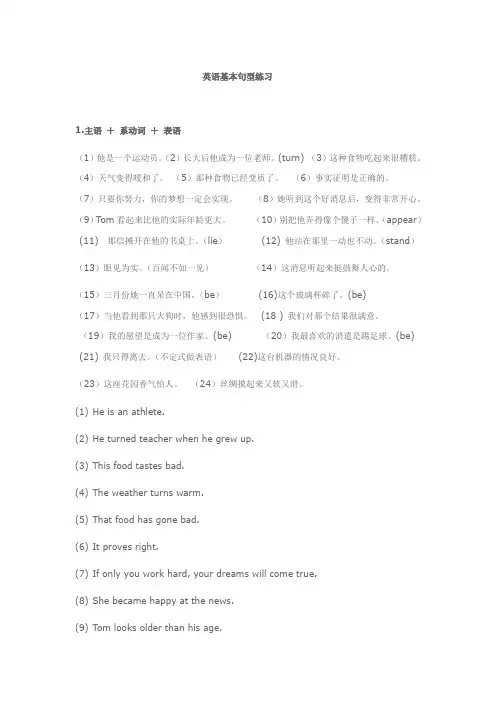
英语基本句型练习1.主语+系动词+表语(1)他是一个运动员。
(2)长大后他成为一位老师。
(turn) (3)这种食物吃起来很糟糕。
(4)天气变得暖和了。
(5)那种食物已经变质了。
(6)事实证明是正确的。
(7)只要你努力,你的梦想一定会实现。
(8)她听到这个好消息后,变得非常开心。
(9)Tom看起来比他的实际年龄更大。
(10)别把他弄得像个傻子一样。
(appear)(11) 那信摊开在他的书桌上。
(lie)(12) 他站在那里一动也不动。
(stand)(13)眼见为实。
(百闻不如一见)(14)这消息听起来挺鼓舞人心的。
(15)三月份她一直呆在中国。
(be)(16)这个玻璃杯碎了。
(be)(17)当他看到那只大狗时,他感到很恐惧。
(18 ) 我们对那个结果很满意。
(19)我的愿望是成为一位作家。
(be) (20)我最喜欢的消遣是踢足球。
(be) (21) 我只得离去。
(不定式做表语)(22)这台机器的情况良好。
(23)这座花园香气怡人。
(24)丝绸摸起来又软又滑。
(1)He is an athlete.(2)He turned teacher when he grew up.(3)This food tastes bad.(4)The weather turns warm.(5)That food has gone bad.(6)It proves right.(7)If only you work hard, your dreams will come true.(8)She became happy at the news.(9)Tom looks older than his age.(10)Don’t make him appear foolish.(11)That letter lies open on his desk.(12)He stood still there.(13)Seeing is believing.(14)The news sounds encouraging.(15)She was in China this March.(16)This glass is broken.(17)When he saw the big dog, he felt afraid.(18)We were satisfied about the result.(19)My wish is to become a writer.(20)My favorite pastime is playing football.(21)I am to leave.(22)This machine is good.(23)This garden smells pleasant.(24)Silk feels soft and smooth.2.主语+谓语(1)学生们很努力学习。
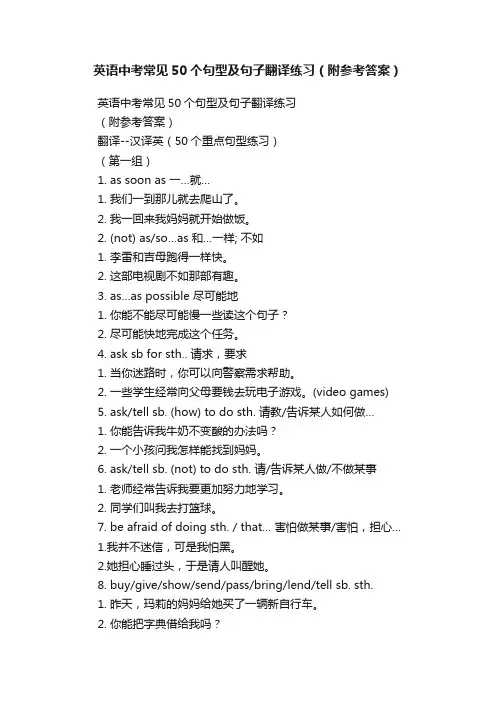
英语中考常见50个句型及句子翻译练习(附参考答案)英语中考常见50个句型及句子翻译练习(附参考答案)翻译--汉译英(50个重点句型练习)(第一组)1. as soon as 一…就…1. 我们一到那儿就去爬山了。
2. 我一回来我妈妈就开始做饭。
2. (not) as/so…as 和…一样; 不如1. 李雷和吉母跑得一样快。
2. 这部电视剧不如那部有趣。
3. as…as possible 尽可能地1. 你能不能尽可能慢一些读这个句子?2. 尽可能快地完成这个任务。
4. ask sb for sth.. 请求,要求1. 当你迷路时,你可以向警察需求帮助。
2. 一些学生经常向父母要钱去玩电子游戏。
(video games) 5. ask/tell sb. (how) to do sth. 请教/告诉某人如何做…1. 你能告诉我牛奶不变酸的办法吗?2. 一个小孩问我怎样能找到妈妈。
6. ask/tell sb. (not) to do sth. 请/告诉某人做/不做某事1. 老师经常告诉我要更加努力地学习。
2. 同学们叫我去打篮球。
7. be afraid of doing sth. / that… 害怕做某事/害怕,担心…1.我并不迷信,可是我怕黑。
2.她担心睡过头,于是请人叫醒她。
8. buy/give/show/send/pass/bring/lend/tell sb. sth.1. 昨天,玛莉的妈妈给她买了一辆新自行车。
2. 你能把字典借给我吗?9. be famous/late/ready/sorry for…1. 对不起,我上课迟到了。
2. 法国以美食和红酒著名。
10. be glad that… 高兴…1.我很高兴你能来看我。
2.真高兴你被那所知名大学录取了。
(第二组)11. both…and… …与…两者都…1. 老师把这件事既告诉我又告诉她。
2. 同学们既喜欢打篮球又喜欢踢足球。
12. either…or 要么…要么…1. 在会上,你要么说汉语要么说英语。

固定句式大全带翻译Fixed Sentence Patterns with Translation: A Comprehensive Guide。
Introduction。
In this article, we will explore a comprehensive guide to fixed sentence patterns with translation. Fixed sentence patterns are structures that are commonly used in both spoken and written languages. They are phrases or sentences that have a fixed structure and are used repeatedly. Understanding these patterns is essential for effective communication in any language.1. "It is (adjective) to (verb)"This sentence pattern is used to express opinions or feelings about an action. For example, "It is important to exercise regularly" or "It is necessary to study hard to pass the exam." The adjective can be replaced with anyother adjective that expresses an opinion or feeling.2. "Not only (subject) but also (subject)"This sentence pattern is used to express two ideas that are both important. For example, "Not only do I enjoy playing tennis, but I also like watching it." The structure of the sentence can be changed to fit the context of the conversation or text.3. "Either (subject) or (subject)"This sentence pattern is used to express a choice between two options. For example, "Either we go to the beach or we go to the park." The structure of the sentence can be changed to fit the context of the conversation or text.4. "Neither (subject) nor (subject)"This sentence pattern is used to express a negative choice between two options. For example, "Neither John norMary wants to go to the party." The structure of the sentence can be changed to fit the context of the conversation or text.5. "If (subject) (verb), (subject) (verb)"This sentence pattern is used to express a conditional statement. For example, "If it rains, we will stay inside. If it is sunny, we will go to the beach." The structure of the sentence can be changed to fit the context of the conversation or text.6. "The (adjective) (subject) (verb)"This sentence pattern is used to describe a noun with an adjective. For example, "The beautiful flowers bloom in the spring." The adjective can be replaced with any other adjective that describes the noun.7. "To (verb) or not to (verb), that is the question"This sentence pattern is a famous quote fromShakespeare's play Hamlet. It is used to express a dilemma or difficult decision. For example, "To study abroad or not to study abroad, that is the question."8. "As (adjective) as (noun)"This sentence pattern is used to compare two things. For example, "The lake is as blue as the sky." Theadjective can be replaced with any other adjective that compares the two things.9. "The more (adjective), the more (adjective)"This sentence pattern is used to express a correlation between two things. For example, "The more you practice, the better you will become." The adjectives can be replaced with any other adjectives that express a correlation.10. "There is/are (number) (noun) in the (place)"This sentence pattern is used to express the quantity of something in a specific location. For example, "Thereare five apples in the basket" or "There is one cat in the room." The structure of the sentence can be changed to fit the context of the conversation or text.Conclusion。

文言文固定句式例句及翻译(一)表示疑问的习惯说法:如……何若……何奈……何这是三个意义相同的表示疑问的习惯说法,中间可以插入名词、代词和短语,可以译为“把……怎么样”、“对……怎么办”、“怎样对付(处置、安顿)。
”例如:①其如土石何?——又能把土块石头怎么样呢?②不能正其身,如正人何?——如果不能端正自身的行为,怎能使别人端正呢?”在这种习惯说法中,如果插入“之”,就构成“如之何”、“若之何”、“奈之何”,可译为“为什么”或“怎么办”。
例如:林父之事君也,进思尽忠,退思补过,社稷之卫也,若之何杀之?——荀林父侍奉国君,在朝廷做官,就忠心耿耿报效君主;辞官隐退时,就反省自己,以弥补过失。
实为国家的栋梁之臣,怎能为一时失职而杀他!“何如”,相当于“怎样”“哪个”。
“陛下以降侯周勃何如人也?”上曰:“长者也。
”(《史记·张释之列传》)——“陛下以降侯周勃是个怎样的人?”皇上说:“忠厚长者。
”又如:因问明帝:“长安何如日远?”(《世说新语·夙愿》)——因此问明帝:“长安与太阳哪个远?”“乎哉”,如侧重“乎”,则表疑问语气,相当于“吗”;如侧重“哉”,则表感叹语气,相当于“啊”。
若寡人者,可以保民乎哉?(《孟子·齐桓晋文之事》)——比如我这样的人,可以保护百姓吗?董生勉乎哉!(韩愈《送董邵南序》)——董生自勉啊!“何……为”,表疑问语气,译为“为什么……呢”。
人曰:“子,卒也,而将军自吮其疽,何哭为?”(《史记·孙吴列传》)——有人说:“你儿子,只是个小兵,但将军亲自为他吮吸疽脓,你为什么哭呢?”(二)表示比较的习惯说法:……孰与…… ……何如…… ……孰若…… ……何若……这些习惯说法都是表示比较,用来表示人或事物互相比较的结果。
都可译为“跟……比较,哪个更……”。
例如:①公之视廉将军孰与秦王?——你们认为廉颇将军和秦王比谁更厉害?②汝意谓长安何如日远?——你认为长安与太阳相比,哪个更远?③吾孰与城北徐公美?——我和城北的徐公比谁更美?(三)表示反问的习惯用法1、不亦……乎?可译为“不是……吗?”或“难道不……吗?”例如:①学而时习之,不亦说乎?②今吾之优越,犹人只有腹心疾也,而王不先越而乃务齐,不亦谬乎?——现在的越国是心腹大患,但大王不先讨伐越国而去讨伐齐国,不就是错了嘛!2、何(以)……为?何……焉为?可译为“要……干什么呢?”或“哪里用得着……呢?”例如:①吾有车而使人不敢借,何以车为?——我有车但是如果别人都不敢来借,那我还要车干什么呢?②如今人方为刀俎,我为鱼肉,何辞为?3、何……之有可译为:“有……呢?”例如:①吾从北方闻子为梯,将以攻宋。
常见的固定句式有:1、不亦……乎?(不是……吗?)例句:有朋自远方来,不亦说乎?2、其……乎(欤)?(难道……吗?)例句:今其智乃反不能及,其可怪也欤?3、得无……乎(耶)得非……乎?(恐怕……吧?莫非……吧?)例句:览物之情,得无异乎?得无教我猎虫所耶?得非不私一钱之杨继宗乎?4、何……为(焉为)?(还要……干什么)例句:匈奴未灭,何以家为?如今人方为刀俎,我为鱼肉,何辞为?5、其……之谓也(乎)(说的大概就是…………之谓也(说的就是……啊)例句:李将军之谓也(高考题)闻道百,以为莫己若者,我之谓也诗云:他人有心,予忖度之——夫子之谓也。
6、直……耳、唯……耳(只是……罢了)例句:直不百步耳,是亦走也。
寡人非能好先王之乐也,直好世俗之乐耳。
7、无异……也(不要感到奇怪)例句:王无异于百姓之以王为爱也(大王对老百姓认为您是吝啬的不要感到奇怪)8、庶几……与(欤)(大概不会……吧)例句:吾王庶几无疾病与?9、如……何、奈……何(把……怎么办对……怎么办)例句:如太行、王屋何?沛公大惊,曰:为之奈何?10、是何异于……(这同……有什么区别呢?)例句:是何异于刺人而杀之,曰:非我也,兵也。
11、孰与……例句:沛公曰:孰与君少长?(他和你比,谁小谁大?)12、庸……乎?(难道……吗?)例句:虽卧洛阳,庸得安枕乎?夫庸知其年之先后生于吾乎?13、其(岂)……(欤)乎?抑……乎(欤)?(难道是……还是……)例句:其竟以此而殒其生乎?抑别有疾而致斯乎?14、然则、虽然、若何、奈何、有所、无所、有以、无以、以……为、是故、所以请同学们自己从书本里各找一个例句翻译练习:1、我中国其果老大乎?2、夫子何命焉为?3、用志不分,乃凝于神,其佝偻丈人之谓乎?4、且自谓孰与诸子贤?5、袁人大愤,然未有以报也。
高考语文文言文固定句式-翻译(整理版)所谓“固定句式”,就是某些结合在一起、作为一个整体来使用,理解时不能分开、而需要按照某种固定模式来解释的词语。
1、“有……者”此式用于所要介绍、陈述的对象,是一种特殊的定语后置形式。
译为“有个……的人”。
例如《口技》:“京城有善口技者。
”2、“以……为……” 此式用“以”组成介词结构作状语,来表示动词“为”所凭借的和依据的对象等。
可译为“用……做……”或“把……当作……”。
例如《六国论》:“至丹以荆卿为计,始速祸焉。
”有时也可紧缩成“以为”。
例如《黔之驴》:“虎见之,庞然大物也,以为神。
”3、“有(无)所”此式中“所”与后边的动词,构成名词性的“所”字词组,作动词“有(无)”的宾语。
可译为“有(没有)……的(人、事、物)”。
如《鸿门宴》:“吾入关,秋毫不敢有所近。
”《木兰诗》:“女亦无所思,女亦无所忆。
”4、“有(无)以” 此式是动词“有”和介词“以”连用于谓语动词前,对某种事情赖以实现的条件、办法等加以肯定(或否定)。
译为“有(没有)什么办法用来……”。
例如《中山狼传》:“吾终当有以活汝。
”《劝学》:“不积小流,无以成江海。
”5、“是以”此式用于因果句中表示结果或推断。
译为“所以(因此)……”。
如《石钟山记》:“余是以记之。
”6、“何所”此式系“所……,(是)何”的主谓倒装式。
译为“所……的(人、东西、事物),是(谁)什么”。
如《木兰诗》:“问女何所思?”7、“所以”此式由于介词“以”,含有“用”、“因”等不同的意义,据此,可译为:①“用来……的工具(方法、方式)”;“凭他(它)来……的”。
例如:《公输》:“吾知所以距子矣。
”《师说》:“师者,所以传道受业解惑也。
”②“导致……的原因”;“……的缘故”。
例如《察今》:“此其所以败也。
”8、“然则”此式表示承上的连接关系。
译为“既然这样,那么……”或“那么”。
例如《岳阳楼记》:“然则北通巫峡,南极潇湘……”9、表示比较的习惯说法:……孰与……;……何如……;……孰若……;……何若……这些习惯说法都是表示比较,用来表示人或事物互相比较的结果。
1、翻译下面文言文中划线的部分(5分)星隧木鸣,国人皆恐。
曰:是何也?曰:无何也。
是天地之变,阴阳之化,物之罕至者也。
怪之可也,而畏之非也。
夫日月之有蚀,风雨之不时,怪星之党见,是无世而不常有之。
2、将下面文中画线的句子译成现代汉语(5分)(1)墨子怒耕柱子①,耕柱子曰:“吾无逾于人乎?”墨子曰:(2)“吾将之太行②,驾骥与牛,子交谁驱?”耕柱子曰:“将驱骥也”。
墨子曰:“何故?”耕柱子曰:“骥足以责。
”墨子曰:“吾亦以子为足以责。
”[注] ①[耕柱子]墨子的学生。
②[太行]太行山。
(1)_____________________________________________________________(2)_____________________________________________________________ 3、将画线语句译成现代汉语。
(5分)儒书言董仲舒读《春秋》,专精一思,志不在他,三年不窥园菜。
夫言不窥园菜,实也;言三年,增之也。
仲舒虽精,亦时解休;解休之间,犹宜游于门庭之侧;则能至门庭,何嫌不窥园菜?闻用精者察物不见,存道以亡身,不闻不至门庭,坐思三年,不及窥园也。
(《论衡·儒增》)①仲舒虽精,亦时解休:________________________________________(3分)②存道以亡身:_________________________________(2分)4、阅读下面一段文字,完成文后各题。
(5分)张嘉贞落魄有大志,亦不自异,亦不下人,自平乡尉免归乡里,布衣环堵①之中,萧然自得。
时人莫之知也。
张循宪以御史出,还次蒲州驿。
循宪方复命,使务有不决者,意颇病之。
问驿吏日:"此有好客乎?"驿吏白以嘉贞。
循宪召与相见,咨以其事积时凝滞者,嘉贞随机应之,莫不豁然。
及命表,又出意外。
他日,则天以问循宪,具以实对,因请以已官让之。
15种固定句式翻译练习1.无乃……乎?①劳师以袭远,非所闻也。
师劳力竭,远主备之,无乃不可乎?使军队疲劳去袭击远方的国家,没有听到过这样的事。
军队疲劳力量竭尽,远方的君主对这件事有准备,恐怕不行吧?②暮婚而晨别,无乃太匆忙?晚上结婚而早上就得离别,只怕太匆忙了吧?③求!无乃尔是过与?冉求!恐怕该责备的是你们吧?)2.……孰与……①吾孰与城北徐公美?我跟城北的徐公相比谁更漂亮?②沛公曰:“孰与君少长?”(项伯)跟你相比,谁的年纪大,谁的年纪小?③公之视廉将军孰与秦王?你们看廉将军跟秦王相比,怎么样?④某业所就,孰与仲多?我所完成的功业跟二哥相比,谁更多?3.……之谓也其……之谓也①闻道百,以为莫己若者,我之谓也。
听到了一些道理,以为天下没有谁超过自己了,说的就是我这种人啊!②诗曰:“他人有心,予忖度之。
”——夫子之谓也。
《诗经》上说:“别人有什么心思,我猜测得到它。
”说的就是夫子这样的人啊!③太史公曰:“传曰:‘其身正,不令则行;其身不正,虽令不从。
’其李将军之谓也。
太史公说:“《论语》上说:‘他自身端正,不下达命令人民就会行动;他自身不端正,即使下达命令他的百姓也不会听从。
’大概说的就是李将军这样的人吧!”4.得无……乎?得无……耶?①览物之情,得无异乎?看到自然景物所产生的思想感情,恐怕不一样吧?②得无教我猎虫所耶?莫非告诉我捕捉蟋蟀的地方吧?③若辈得无苦贫乎?你们恐怕被穷困所苦吧?④得无楚之水土使民善盗耶?莫非楚国的水土使老百姓善于偷盗吧?⑤日饮食得无衰乎?每天的饮食该不会减少吧?5.奈……何如……何若……何①以君之力,曾不能损魁父之丘,如王屋、太行何?把太行山和王屋山能怎么样呢?②试问古来几曾见破镜能重圆?则较死为苦也,将奈之何?(我们)对这种情况怎么办呢?③力拔山兮气盖世,时不力兮骓不逝。
骓不逝兮可奈何?虞兮虞兮奈若何?虞姬虞姬把你怎么样呢?6.何有于……?①子曰:“默而识之,学而不厌,诲人不倦,何有于我哉?”对于我来说又有什么呢?7.何……为?①如今人方为刀俎,我为鱼肉,何辞为?还要告辞做什么呢?②项王笑曰:“天之亡我,我何渡为?”这是上天要灭亡我,我还要渡江做什么呢?8.不亦……乎?①舟已行矣,而剑不行,求剑若此,不亦惑乎?像这样寻找剑,岂不是太糊涂了吗?②吾射不亦精乎?我射箭的本领不是很高明吗?③子曰:“学而时习之,不亦说乎?有朋自远方来,不亦乐乎?人不知而不愠,不亦君子乎?”学习并且不时地温习它,不是很快乐了的吗?有同学从远方来,不也是很高兴的事吗?别人不了解自己而不恼怒,不也是君子吗?9.有……者①人有亡斧者。